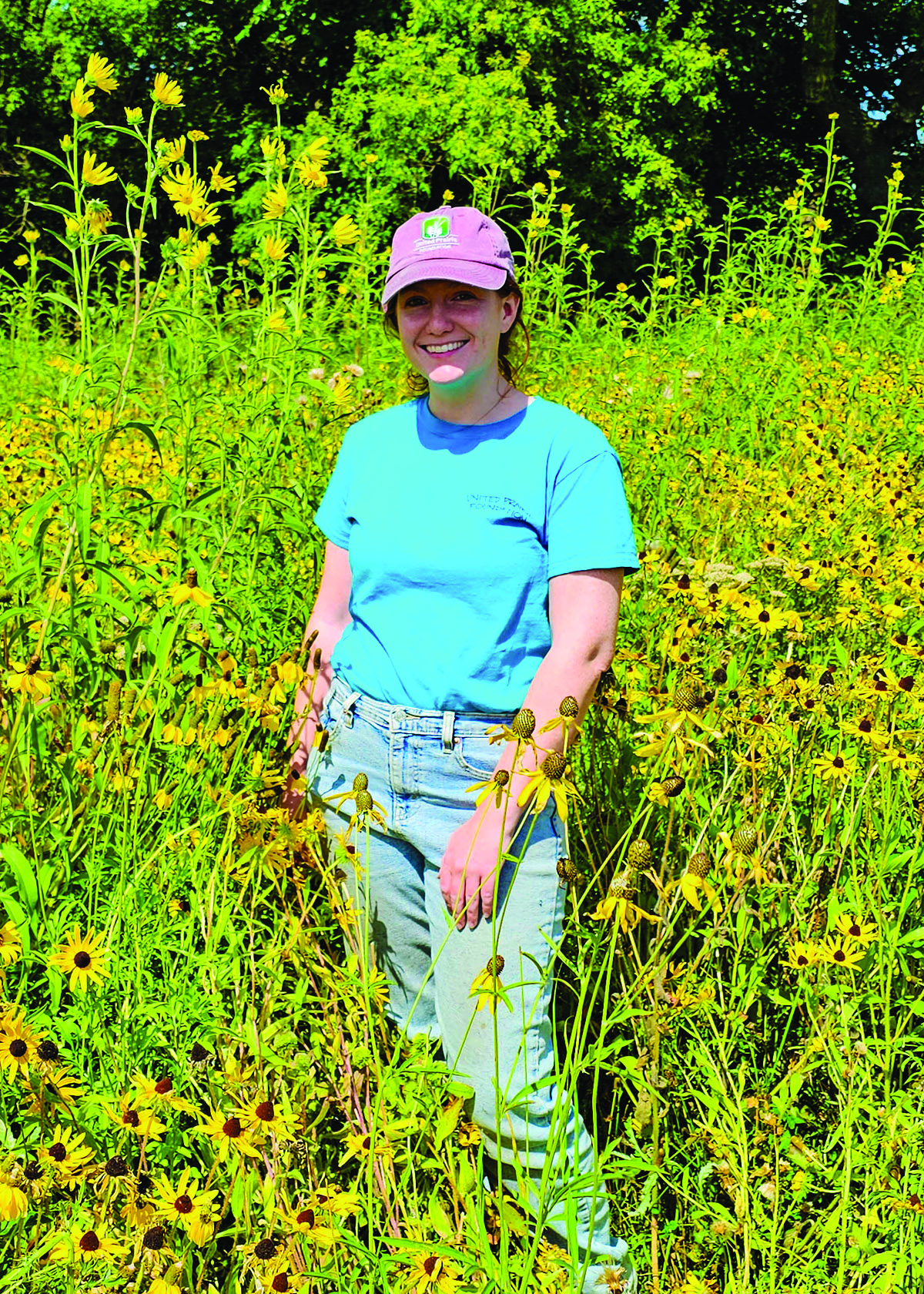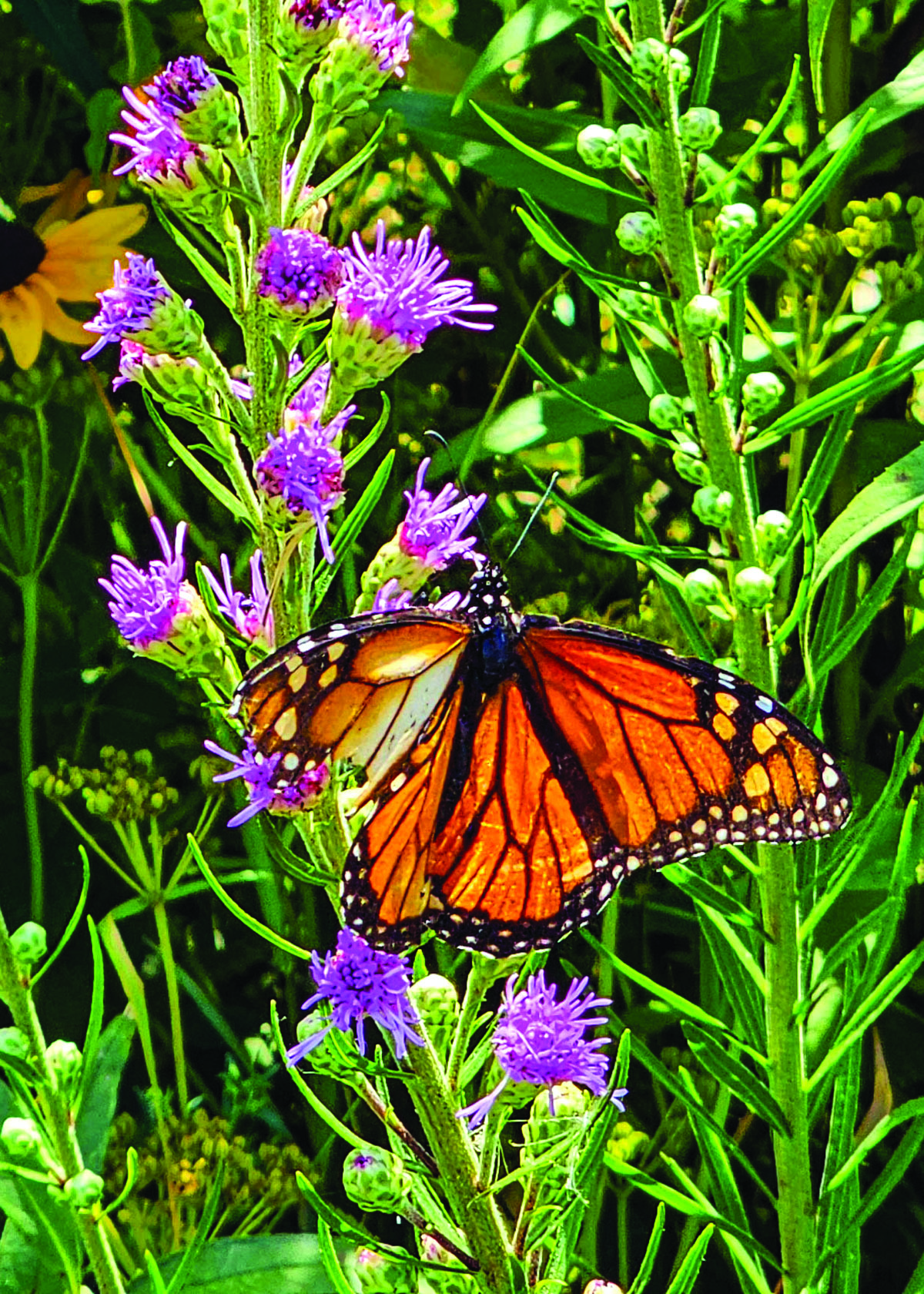
Patrice Delaney stands amidst a section of native prairie sunflowers and other species planted by the United Prairie Foundation at M.B. Johnson Park. (Photos/Nancy Hanson.)

A Monarch butterfly, bedraggled after a busy summer, sips nectar from meadow liatris blossoms at M.B. Johnson Park.
Nancy Edmonds Hanson
Four years after the tragic “Monarch Massacre,” plots of blooming plants native to the prairie are providing respite to the bright orange butterflies, soon to begin their cross-continental migration south to the lands where they winter in Mexico.
“Butterflies are very selective about what they eat and where their eggs are laid,” Patrice Delaney observes, working her way through the native prairie plantings bordering forest and pond at M.B. Johnson Park on the north side of Moorhead. “Monarchs depend on milkweed and only a few other flowering plants, like meadow liatris, to survive. They nourish them and prepare this final hatch of the summer for their 3,000-mile flight to their wintering area.”
Since the killing of tens of thousands of monarchs by aerial spraying for mosquitoes, the Fargo-Moorhead area has become more alert to the needs of the beneficial insect pollinators that have always called the region “home.” Not only the variety of butterflies are affected by the shrinking of the native prairie for which they’re well adapted. Dragonflies – avid consumers of mosquitoes – and many species of bees indigenous to the Northern Plains depend on the plants that thrived here … now reduced to rare uncultivated tracts, mostly replaced by agriculture and residential lawns. Most of the fields and yards are now populated with commercially bred plants and crops whose roots lie in distant locales or laboratories.
With the help of the United Prairie Foundation of Sheldon, North Dakota, Moorhead has been making progress in restoring the greenery that, not so long ago, covered the prairie on which the city was built. The 10-year-old nonprofit’s crew has planted about 15 acres within the city, most of it in large tracts in M.B. Johnson and Southside Regional parks.
Starting last year with transplanted plugs – young plants started in a greenhouse – the parklands are now abloom with species of yellow sunflowers, purple liatris and a host of others in white, yellow and orange. This summer, less showy additions were seeded by the foundation’s crew of five, including founder John DeVries. Much of the cost has been underwritten by a grant from the Department of Natural Resources’ Conservation Partners Legacy, part of the fund that was established by Minnesota voters in 2008.
The variety of native additions is a key part of the strategy of restoring the environment to what it was before civilization put it in second place. “Every prairie species has four or five insects that depend on it,,” Delaney explains. “And there are hundreds of plants that thrive in the native prairie.”
A Moorhead native, she worked as an Americorps volunteer after graduating from Minnesota State University Moorhead in 2021 with a major in ecology and evolutionary biology. Her first assignments was with in Pennington County, working with its Soil and Water Conservation District. She went on to spend two years with the Community Forestry Corps in Moorhead’s Forestry Department, where she helped plan the restored prairie tracts and other projects. “I pruned and planted a lot of trees,” she says, summing up her experience. She moved to the United Prairie Foundation earlier this year.
While weeds like buck thorn and Canada thistle are the threats that bedevil most householders, Delaney says the greatest concern in restoring tracts of prairie is imported grasses like smooth brougham. “It was brought here by our European ancestors for early- and late-season grazing for their cattle,” she says. “The problem is that they infiltrate the fields and leave nothing for mid season. That eventually eliminates the natural biodiversity, and leaves the habitat in which leafy spurge and thistles thrive.”
Nor is she a fan of the cheerful bright yellow invaders called bird’s foot trefoil. “It may be pretty, popping up in grassy areas, but it’s a very aggressive weed,” she warns. If you want blossoms in your lawn, she suggests, go for white or yellow sweet clover. They’re pretty, as well as beneficial to the environment.
Harvest season is coming up for the United Prairie Foundation. The crew is about to harvesting seeds in their fields near Enderlin. Some are gathered by hand; others are combined like grain fields, mixing the species into the same medley that nature has intended for eons. Later, controlled burns will clear the fields, eliminating weeds that could sully next year’s crops of prairie natives.
Delaney suggests that homeowners can take several steps to encourage environments that nurture the monarchs and other beneficial bugs. “Grow milkweed and other plants that belong in our natural environment,” she says. “Come to the parks and experience these natural sections. Educate yourself about plant species. so that you can tell natives from non-natives.”
Over time, your perspective – like hers – may change. She says she no longer regards the typical carefully landscaped yard as beautiful: “Instead, I see the beauty in the natural habitat. The plants create an environment in which the birds, mammals, amphibians and yes, the insects, all can thrive. Walking through native prairie, you hear the buzzing, the bird songs, the rustling of plants – the sound of the whole ecosystem working perfectly together. It’s a wonderful noise.”


